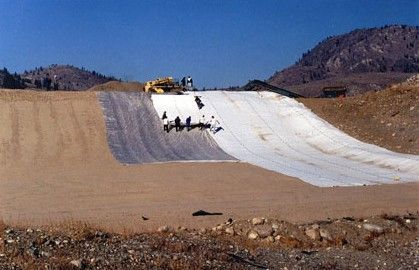- Understanding the Role of Geomembrane Liners in Waste Management
- Innovations in Geomembrane Liners for Water Management
- Geomembrane Liners: A Comprehensive Guide
- The Future of Geomembrane Liners in Civil Engineering
- Geomembrane Liners: Enhancing Landfill Stability
Manager:
WhatsApp:+86 177 0135 2670
Tel:+86 177 0135 2670
Email:marketing@okorder.com
Address:3rd Floor, No.2 Building, No.1 Sanlihe Road
The Importance of Geomembrane Liners in Pond Lining
Geomembrane liners have become an essential component in the construction and maintenance of ponds. These versatile liners are designed to provide a waterproof barrier that prevents the leakage of water and contaminants, ensuring the structural integrity and environmental safety of the pond. In this article, we will explore the importance of geomembrane liners in pond lining, their benefits, and the factors to consider when choosing the right liner for your pond project.

The Role of Geomembrane Liners in Pond Construction
Geomembrane liners are synthetic materials, typically made from high-density polyethylene (HDPE), low-density polyethylene (LDPE), or ethylene propylene diene monomer (EPDM) rubber. They are used to create a seamless, watertight barrier that prevents water from seeping into the surrounding soil and groundwater. This is particularly important in areas where water conservation and environmental protection are a priority.
Imagine a pond without a proper liner. The water would quickly seep into the ground, leaving you with a dry, muddy hole. But with a geomembrane liner, you can maintain the water level and create a beautiful, sustainable pond that can be enjoyed for years to come.
Environmental Protection and Containment
One of the key benefits of using geomembrane liners is their ability to contain contaminants. Whether you're dealing with industrial waste, agricultural runoff, or even residential wastewater, these liners can prevent harmful substances from leaching into the environment. This is crucial for protecting local ecosystems and ensuring the health of both wildlife and humans.
Aesthetic Appeal and Functionality
Beyond their practical applications, geomembrane liners also contribute to the aesthetic appeal of a pond. A well-lined pond not only looks more polished and professional but also provides a stable platform for aquatic plants and animals to thrive. This, in turn, can attract a variety of wildlife, enhancing the overall biodiversity of the area.
Factors to Consider When Choosing a Geomembrane Liner
When selecting a geomembrane liner for your pond, there are several factors to consider:
- Material: The type of material used in the liner will determine its durability, flexibility, and resistance to chemicals and UV radiation. HDPE is known for its strength and longevity, while LDPE and EPDM offer flexibility and resistance to punctures.
- Thickness: The thickness of the liner will affect its puncture resistance and lifespan. Thicker liners are generally more durable but can be more expensive and difficult to install.
- Size: Ensure that the liner is the right size for your pond. A liner that is too small will not provide full coverage, while one that is too large may be difficult to manage and install.
- Compatibility: Consider the compatibility of the liner with other pond components, such as pumps, filters, and plants. Some liners may be more suitable for certain types of pond ecosystems than others.
- Cost: Geomembrane liners can vary significantly in price. It's important to balance the cost with the quality and longevity of the liner to ensure you're getting the best value for your investment.
Installation and Maintenance
Proper installation of a geomembrane liner is crucial to its effectiveness. Follow these steps for a successful installation:
1. Prepare the Subgrade: Ensure the area where the liner will be placed is clean, smooth, and free of any debris or sharp objects that could puncture the liner.
2. Unroll the Liner: Carefully unroll the liner, taking care not to damage it. Position it so that it covers the entire pond area.
3. Secure the Edges: Use anchoring methods such as trenches, weights, or straps to secure the edges of the liner and prevent it from shifting.
4. Inspect for Damage: Regularly inspect the liner for any signs of wear, punctures, or leaks. Address any issues promptly to maintain the integrity of the pond.
The Future of Geomembrane Liners
As technology advances, so too do the materials and methods used in the construction of geomembrane liners. Innovations in material science are leading to the development of liners that are more durable, flexible, and environmentally friendly. These advancements promise to make pond construction and maintenance even more efficient and sustainable in the future.
In conclusion, geomembrane liners play a vital role in pond construction and maintenance. They offer a range of benefits, from environmental protection to aesthetic appeal, and are an investment worth considering for anyone looking to create or maintain a pond. By understanding the factors involved in choosing the right liner and following proper installation and maintenance practices, you can ensure that your pond remains a beautiful and functional feature for years to come.
- Previous:Choosing the Right Geomembrane Liner for Your Project
- Next:Geomembrane Liners: Enhancing Landfill Stability
-
2024-12-05Geomembrane Liners: A Comprehensive Guide






